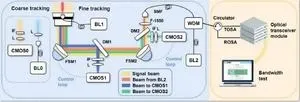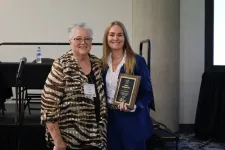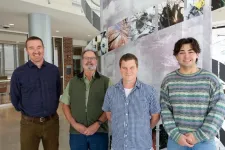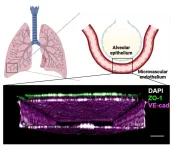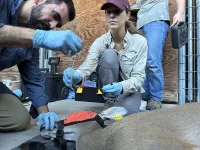(Press-News.org) In a world that relies on high-speed internet and seamless communication, the absence of a reliable fiber connection can be a significant hurdle. Fortunately, a cutting-edge technology known as free-space optical communication (FSO) offers a flexible solution for field-deployable high-speed wireless communication in areas where fiber connections are unavailable.
FSO has garnered attention for its versatility across various scales of operation. On a global level, it plays a crucial role in establishing high-speed satellite internet projects like Starlink, ensuring global connectivity. At the ground level, particularly in low-altitude scenarios, FSO shines as an attractive option for last-mile connections, disaster recovery efforts, and military communications.
Miniaturized FSO system
In a significant technological leap, researchers from Nanjing University (NJU) have developed a miniaturized FSO system that promises to revolutionize high-speed wireless communication. As reported in the Gold Open Access journal Advanced Photonics Nexus (APNexus), this remarkable system achieved an astonishing communication bandwidth of 9.16 gigabytes per second (Gbps) over a 1-kilometer (km) link. What sets it apart is that it accomplishes such high FSO performance using readily available commercial fiber optical communication transceiver modules (no need for optical amplification).
The core of this miniaturized FSO system comprises a pair of FSO devices. Each FSO device is compact, measuring just 45 cm × 40 cm × 35 cm, with a weight of 9.5 kilograms and a power consumption of approximately 10 watts. Each houses an optical transceiver module, an acquisition, pointing, and tracking (APT) device, and its control electronics, all safely sealed within a box for rugged outdoor operation. The APT device stands out with its low-diffraction optical design and a highly efficient 4-stage closed-loop feedback control system.
The FSO system exhibits remarkable tracking capabilities, through the integration of multiple sensors and sophisticated algorithms, which enable automatic, fast, and highly accurate acquisition and fine tracking in just 10 minutes. This precision keeps the tracking error within an impressive 3 microradians (μrad), resulting in a low average link loss of just 13.7 decibels (dB) over the 1-km link. Such precision also eliminates the need for optical amplification. Remarkably, the FSO system can achieve bidirectional data rates averaging 9.27 Gbps over the 1-km link, using only commercial transceiver modules.
According to Zhenda Xie, professor at the NJU School of Electronic Science and Engineering and corresponding author for the APNexus article, “This work highlights the potential for achieving FSO using commercially available fiber optical transceiver modules.” Xie notes that the effective distance of 1 km may be extended; his team also tested the optical links at up to 4 km, where the average loss increased to 18 dB – likely due to a foggy test environment. “With better weather conditions and optical amplification, longer FSO can be expected,” Xie concludes.
The implications of this achievement are profound. This miniaturized FSO breakthrough unlocks the potential for high-speed wireless communication virtually anywhere, making connectivity happen even in the most challenging environments. As we look ahead, these devices are set to play a pivotal role in the future of FSO networks, offering plug-and-play configurations that can establish high-speed FSO channels in minutes. This innovation addresses the growing need for field-deployable, high-speed wireless communication solutions, bridging the connectivity gap in a world where staying connected is more critical than ever.
For details, read the Gold Open Access article by Liu, Zhang, et al., “High-speed free-space optical communication using standard fiber communication components without optical amplification,” Adv. Photon. Nexus 2(6) 065001 (2023), doi 10.1117/1.APN.2.6.065001.
END
Miniaturized FSO breakthrough unlocks high-speed wireless communication anywhere
From space-wide internet to last-mile connectivity, portable free-space optical communication promises to bridge connectivity gaps on-demand
2023-10-17
ELSE PRESS RELEASES FROM THIS DATE:
Pennington Biomedical’s Dr. Leanne Redman selected for top honor by The Obesity Society
2023-10-17
BATON ROUGE – The Obesity Society – the leading professional society focused on obesity science, treatment and prevention – has named Pennington Biomedical’s Dr. Leanne Redman as the recipient of the 2023 TOPS Research Achievement Award. The award, which is funded by the Take Off Pounds Sensibly, or TOPS, Foundation, was presented to Dr. Redman on Monday, Oct. 16, in recognition of her contributions to research in the field of obesity.
Considered by many to be the top award for obesity research, Dr. ...
New technique helps robots pack objects into a tight space
2023-10-17
CAMBRIDGE, Mass. -- Anyone who has ever tried to pack a family-sized amount of luggage into a sedan-sized trunk knows this is a hard problem. Robots struggle with dense packing tasks, too.
For the robot, solving the packing problem involves satisfying many constraints, such as stacking luggage so suitcases don’t topple out of the trunk, heavy objects aren’t placed on top of lighter ones, and collisions between the robotic arm and the car’s bumper are avoided.
Some traditional methods tackle this problem sequentially, guessing a partial solution ...
Mitochondrial protein plays key role in glioblastoma and therapeutic resistance
2023-10-17
Glioblastoma is the most common type of brain tumor that affects adults and, unfortunately, still remains incurable. In a new study, researchers have demonstrated that a specific mitochondrial protein plays an important role in glioblastoma, and can therefore be used as a potential target to reduce tumors.
“Glioblastoma is notorious for its lethality. One of the major challenges is that it spreads invasively throughout the brain. We’re interested in understanding what drives this process in order to identify new therapeutic strategies,” said Brendan Harley (RBTE leader/EIRH), the Robert W. Schaefer Professor of Chemical ...
Whaling wiped out far more fin whales than previously thought
2023-10-17
Key takeaways
Whaling in the 20th century destroyed 99% of the Eastern North Pacific fin whale breeding population.
Because there is enough genetic diversity, current conservation measures should help the population rebound without becoming inbred.
The future of fin whales in the Gulf of California depends on the recovery of the Eastern North Pacific population.
A new genomic study by UCLA biologists shows that whaling in the 20th century destroyed 99% of the Eastern North Pacific fin whale breeding, or “effective,” population — 29% more than previously thought.
But there is also some good news: Genes among members of this endangered ...
Human Lung Chip leveraged to faithfully model radiation-induced lung injury
2023-10-17
By Benjamin Boettner
(Boston) — The lung is one of the tissues most sensitive to radiation in the human body. People exposed to high radiation doses following nuclear incidents develop radiation-induced lung injury (RILI), which affects the function of many cell types in the lung, causing acute and sustained inflammation, and in the longer term, the thickening and scarring of lung tissue known as fibrosis. RILI also is a common side effect of radiation therapy administered to cancer patients to kill malignant cells in their bodies, and can limit the maximum radiation dose doctors can use to control their ...
Texas A&M receives over $1 million in USDA grants to study SARS-CoV-2 in deer
2023-10-17
Texas A&M University scientists and research partners have received two National Institute of Food and Agriculture (NIFA) Agriculture and Food Research Initiative (AFRI) grants to study the spread of SARS-CoV-2 in deer. These funds will help researchers understand the impact of the virus in Texas’ deer populations and its relationship to human and ecological health.
For these projects, the research team will focus on captive deer, which are an agricultural species in Texas, including managed deer that live on large, rural properties enclosed by fences, as well as on the wild deer with which captive deer may interact and deer living ...
SwRI develops novel solution to advance synthesis for nerve agent antidotes
2023-10-17
SAN ANTONIO - October 17, 2023 — Southwest Research Institute has developed a unique technology (US20230242487A1) that enables the safe and efficient synthesis of organophosphorus nerve agent (OPNA) oxime antidotes. Using this technology, SwRI scientists can not only successfully synthesize currently known highly effective nerve agent countermeasures, but also effectively develop promising new drug candidates to treat nerve agent exposure.
Current treatments for OPNA exposure have not changed significantly since the 1950s. OPNAs are odorless and colorless chemicals ...
The Foundation for Angelman Syndrome Therapeutics to advance gene therapy candidate through IND-enabling studies conducted in partnership with the University of Pennsylvania
2023-10-17
October 17, 2023—The Foundation for Angelman Syndrome Therapeutics (FAST) announced today that the non-profit organization has entered into an exclusive global collaborative research and development agreement with the University of Pennsylvania to develop an investigational adeno-associated virus (AAV) gene therapy for Angelman syndrome (AS).
Angelman syndrome is a nondegenerative neurogenetic disorder that is estimated to impact approximately 1 in 15,000 births, or potentially 500,000 individuals world-wide, ...
Harnessing molecular power: electricity generation on the nanoscale
2023-10-17
WASHINGTON, Oct. 17, 2023 – Wave energy technology is a proven source of power generation, but there is power inherent in every molecule of liquid on earth, even when the liquid is at rest. At the molecular scale, atoms and ions are always moving. If this nanoscale movement can be harvested, it could be a big source of energy.
“There are vast amounts of air and liquid on the earth, and their successful harvesting could produce a gigantic amount of energy for society,” author Yucheng Luan said.
In an article published this week in APL Materials, by AIP Publishing, Luan and his collaborators tested a molecular energy harvesting device that captures ...
Study reveals our European ancestors ate seaweed and freshwater plants
2023-10-17
For many people seaweed holds a reputation as a superfood, heralded for its health benefits and sustainability, but it appears our European ancestors were ahead of the game and were consuming the nutrient-rich plant for thousands of years.
Researchers say they have found “definitive” archaeological evidence that seaweeds and other local freshwater plants were eaten in the mesolithic, through the Neolithic transition to farming and into the Early Middle Ages, suggesting that these resources, now rarely eaten in Europe, only ...
LAST 30 PRESS RELEASES:
Why are there so many Nordic mediators?
Young shark species more vulnerable to extinction
Mobile fetal heart monitoring linked to fewer newborn deaths in Tanzania
Bluey’s dad offered professorial chair in archaeology at Griffith University
Beyond small data limitations: Transfer learning-enabled framework for predicting mechanical properties of aluminum matrix composites
Unveiling non-thermal catalytic origin of direct current-promoted catalysis for energy-efficient transformation of greenhouse gases to valuable chemicals
Chronic breathlessness emerging as a hidden strain on hospitals
Paleontologists find first fossil bee nests made inside fossil bones
These fossils were the perfect home for ancient baby bees
Not everyone reads the room the same. A new study examines why.
New research identifies linked energy, immune and vascular changes in ME/CFS
Concurrent frailty + depression likely boost dementia risk in older people
Living in substandard housing linked to kids’ missed schooling and poor grades
Little awareness of medical + psychological complexities of steroid cream withdrawal
Eight in 10 trusts caring for emergency department patients in corridors, finds BMJ investigation
NASA’s Webb telescope finds bizarre atmosphere on a lemon-shaped exoplanet
The gut bacteria that put the brakes on weight gain in mice
Exploring how patients feel about AI transcription
Category ‘6’ tropical cyclone hot spots are growing
Video: Drivers struggle to multitask when using dashboard touch screens, study finds
SLU research shows surge in alcohol-related liver disease driving ‘deaths of despair’
Rising heat reshapes how microbes break down microplastics, new review finds
Roots reveal a hidden carbon pathway in maize plants
Membrane magic: FAMU-FSU researchers repurpose fuel cells membranes for new applications
UN Member States pledge to increase access to diagnosis and inhaled medicines for the 480 million people living with COPD
Combination therapy shows potential to treat pediatric brain cancer ATRT
Study links seabird nesting to shark turf wars in Hawai‘i
Legal sports betting linked to sharp increases in violent crime, study finds
Breakthrough AI from NYUAD speeds up discovery of life-supporting microbes
New Eva Mayr-Stihl Foundation funding initiative boosts research at University of Freiburg on adaptation of forests to global change
[Press-News.org] Miniaturized FSO breakthrough unlocks high-speed wireless communication anywhereFrom space-wide internet to last-mile connectivity, portable free-space optical communication promises to bridge connectivity gaps on-demand

